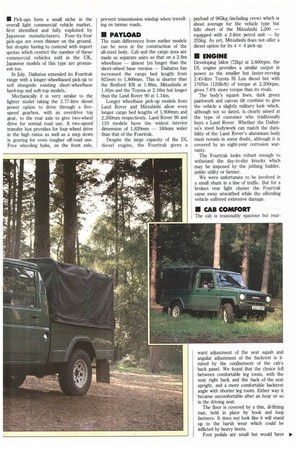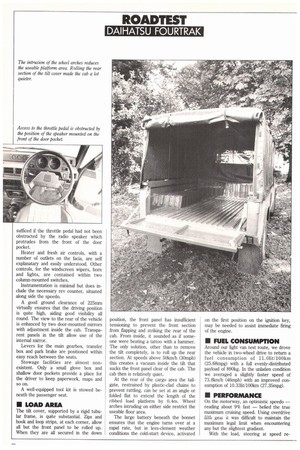PROTRACTED FOURTRAK
Page 60

Page 61

Page 62

Page 63

If you've noticed an error in this article please click here to report it so we can fix it.
The competitively-priced Daihatsu longp-wheelbase 4 4 pick-up is robust and adequately powered.
However, we found problems with the tilt and with seat adjustment. • Pick-ups form a small niche in the overall light commercial vehicle market, first identified and fully exploited by Japanese manufacturers. Four-by-four pick-ups are even thinner on the ground, but despite having to contend with import quotas which restrict the number of these commercial vehicles sold in the UK, Japanese models of this type are prominent too.
In July, Daihatsu extended its Fourtrak range with a longer-wheelbased pick-up to sell alongside existing short-wheelbase hard-top and soft-top models.
Mechanically it is very similar to the lighter model taking the 2.77-litre diesel power option to drive through a fivespeed gearbox, with an overdrive top gear, to the rear axle to give two-wheel drive for normal road use. A two-speed transfer box provides for four-wheel drive in the high ratios as well as a step down in gearing for even tougher off-road use. Free wheeling hubs, on the front axle, prevent transmission windup when travelling on tarmac roads.
• PAYLOAD
The main differences from earlier models can be seen in the construction of the all-steel body. Cab and the cargo area are made as separate units so that on a 2.8m wheelbase — almost lm longer than the short-wheel base version — Daihatsu has increased the cargo bed length from 925inm to 1,800mm. This is shorter than the Bedford KB at 1.86m, Mitsubishi at 1.85m and the Toyota at 2.16m but longer than the Land Rover 90 at 1.14m.
Longer wheelbase pick-up models from Land Rover and Mitsubishi allow even longer cargo bed lengths of 1,900mm and 2,260mm respectively. Land Rover 90 and 110 models have the widest interior dimension of 1,620mm — 160mm wider than that of the Fourtrak.
Despite the large capacity of the DL diesel engine, the Fourtrak gives a payload of 965kg (including crew) which is about average for the vehicle type but falls short of the Mitsubishi L200 — equipped with a 2-litre petrol unit — by 255kg. As yet, Mitsubishi does not offer a diesel option for its 4 x 4 pick-up.
• ENGINE
Developing 54kw (72hp) at 3,600rpm, the DL engine provides a similar output in power as the smaller but faster-revving 2.45-litre Toyota Hi Lux diesel but with 170Nm (125Ib/ft) of torque at 2,200rpm, gives 7.6% more torque than its rivals.
The body's square lines, dark green paintwork and canvas tilt combine to give the vehicle a slightly military look which, although not so dated, is clearly aimed at the type of customer who traditionally buys a Land Rover. Whether the Daihatsu's steel bodywork can match the durability of the Land Rover's aluminium body must remain in some doubt, although it is covered by an eight-year corrosion warranty.
The Fourtrak looks robust enough to withstand the day-to-day knocks which may be imposed by the jobbing builder, public utility or farmer.
We were unfortunate to be involved in a small shunt in a line of traffic. But for a broken rear light cluster the Fourtrak came away unscathed while the offending vehicle suffered extensive damage.
• CAB COMFORT
The cab is reasonably spacious but rear ward adjustment of the seat squab and angular adjustment of the backrest is limited by the confinement of the cab's back panel. We found that the choice fell between comfortable leg room, with the seat right back and the back of the seat upright, and a more comfortable backrest angle with shorter leg room. Either way it became uncomfortable after an hour or so in the driving seat.
The floor is covered by a thin, ill-fitting mat, held in place by hook and loop fastners. It does not look like it will stand up to the harsh wear which could be inflicted by heavy boots.
Foot pedals are small but would have llo sufficed if the throttle pedal had not been obstructed by the radio speaker which protrudes from the front of the door pocket.
Heater and fresh air controls, with a number of outlets on the facia, are self explanatary and easily understood. Other controls, for the windscreen wipers, horn and lights, are contained within two column-mounted switches.
Instrumentation is minimal but does include the necessary rev counter, situated along side the speedo.
A good ground clearance of 225mm virtually ensures that the driving position is quite high, aiding good visibility all round. The view to the rear of the vehicle is enhanced by two door-mounted mirrors with adjustment inside the cab. Transparent panels in the tilt allow use of the internal mirror.
Levers for the main gearbox, transfer box and park brake are positioned within easy reach between the seats.
Stowage facilities are almost nonexistent. Only a small glove box and shallow door pockets provide a place for the driver to keep paperwork, maps and so on.
A well-equipped tool kit is stowed beneath the passenger seat.
• LOAD AREA
The tilt cover, supported by a rigid tubular frame, is quite substantial. Zips and hook and loop strips, at each corner, allow all but the front panel to be rolled up. When they are all secured in the down position, the front panel has insufficient tensioning to prevent the front section from flapping and striking the rear of the cab. From inside, it sounded as if someone were beating a tattoo with a hammer. The only solution, other than to remove the tilt completely, is to roll up the rear section. At speeds above 50km/h (30mph) this creates a vacuum inside the tilt that sucks the front panel clear of the cab. The cab then is relatively quiet.
At the rear of the cargo area the tailgate, restrained by plastic-clad chains to prevent rattling, can be set at an angle or folded flat to extend the length of the ribbed load platform by 0.4m. Wheel arches intruding on either side restrict the useable floor area.
The large battery beneath the bonnet ensures that the engine turns over at a rapid rate, but in less-clement weather conditions the cold-start device, activated on the first position on the ignition key, may be needed to assist immediate firing of the engine.
• FUEL CONSUMPTION
Around our light van test route, we drove the vehicle in two-wheel drive to return a fuel consumption of 11.01it/100km (25.68mpg) with a full evenly-distributed payload of 890kg. In the unladen condition we averaged a slightly faster speed of 73.8km/h (46mph) with an improved consumption of 10.331it/100km (27.35mpg).
• PERFORMANCE
On the motorway, an optimistic speedo — reading about 9% fast — belied the true maximum cruising speed. Using overdrive fifth geai it was difficult to maintain the maximum legal limit when encountering any but the slightest gradient.
With the load, steering at speed re mained positive and the ride, although firm, is not uncomfortable.
At slow speeds the steering lock is poorer than might be expected from a conventional rear-wheel-drive pick-up due to the restriction of the front drive axle.
Hill restarts in two-wheel drive were poor by any standard: we could manage only a 20% (1-in-5 gradient) but with the lower ratio range provided by the twospeed transfer box and using four wheel drive we were unable to find a hill on or off road to prevent us pulling away cleanly and effortlessly.
In four-wheel drive, the steering is slightly heavier, but does not become a problem.
The switch from twoto four-wheel drive can be made while the vehicle is moving slowly, but as the vehicle must stop to allow the front locking hubs to be engaged this provides little advantage. In four-wheel-drive high ratio, the manufacturer advises that maximum speed be limited to 80km/h.
What may be more relevant to cope with severe off-road conditions is that the shift through the dog-leg gate to low ratio can be achieved without coming to a stop.
• SUMMARY
The Fourtrak 4x4 pick-up is a recent addition to the Daihatsu commercial vehicle range, but commercial pressures will limit its availability. Its 2.77 litre naturally aspirated diesel engine does not lack power but was unable to maintain top motorway speeds when fully laden. In addition to its payload of 965kg it provides for a braked towing weight of 2,900kg. Like the payload capacity, its price of 28,449 is competitive.
0 by Bill Brock




































































































